Acta Paedagogica Vilnensia ISSN 1392-5016 eISSN 1648-665X
2019, vol. 42, pp. 29–42 DOI: https://doi.org/10.15388/ActPaed.42.2
Lenin as a Child Visual Propaganda and Pedagogy
Lajos Somogyvári
University of Pannonia Teacher Training Center
Email: tabilajos@gmail.com
Abstract. My study aims to reveal the connections between visual propaganda and pedagogy during the Hungarian state-socialism by analyzing different variations of a single picture of Vladimir Lenin. The ideological indoctrination played an important role in the socialization of children, even teachers; thus, the communist power tried to create a new ceremonial-ritual order and a socialist identity. The following analyzed images (photos and paintings) show different functions and meanings; by reframing and transforming photographs and contexts, we can demonstrate how the viewers could have been manipulated. The starting photo comes from my studies (based upon the corpus of Hungarian pedagogical journals) published in 1970, showing a seemingly unconventional representation: Lenin as a child.
Keywords: visual propaganda, history of education, pedagogical journals, Lenin Cult, communist education.
Leninas kaip vaikas. Vizualinė propaganda ir pedagogika
Santrauka. Tyrimo tikslas – atskleisti vizualinės propagandos ir pedagogikos ryšį socializmo laikotarpiu Vengrijoje, analizuojant įvairius vienos Lenino nuotraukos pateikimo variantus. Idėjų indoktrinacija buvo labai svarbi to meto vaikų ir netgi mokytojų socializacijos procese, todėl komunistų valdžia bandė sukurti naujų ceremonijų ir ritualų tvarką bei socialistinę tapatybę. Straipsnyje analizuojami vaizdai (nuotraukos ir paveikslai) atskleidžia jų skirtingas funkcijas, reikšmes. Parodoma, kaip, keičiant ir transformuojant nuotraukas bei kontekstus, galėjo būti manipuliuojama tais, kam jie buvo skirti. Pirmoji nuotrauka, paimta iš mano tyrimų (juose buvo analizuojamas praėjusio šimtmečio aštunto dešimtmečio Vengrijos pedagogikos žurnalų turinys), rodo netradicinį Lenino kaip vaiko atvaizdą.
Pagrindiniai žodžiai: vizualinė propaganda, švietimo istorija, pedagogikos žurnalai, Lenino kultas, komunistinis švietimas
Received: 02/05/2019. Accepted: 03/06/2019
Copyright ©
This is an Open Access article distributed under the terms of the Creative Commons Attribution Licence (CC BY), which permits unrestricted use, distribution, and reproduction in any medium, provided the original author and source are credited.
Introduction
Cult and Propaganda
Sources, Methodology, and Historical Context
“A Boy Like Any Other”
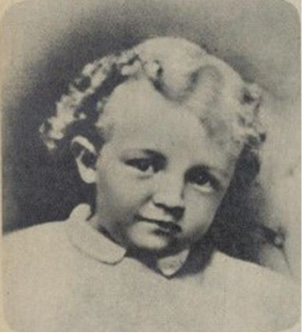
Picture 1. A Boy Like Any Other (detail).
In Gyermekünk (“Our Child”), 1970, Vol. 2. No. 4. page 18.
The spectre of Communism
haunted Europe,
withdrew, then roamed again
throughout its girth.
For all these reasons
in Simbirsk, […]
Lenin,
a boy like any other,
came to birth.
(Mayakovsky 1965, p. 197)
•
•
•
•
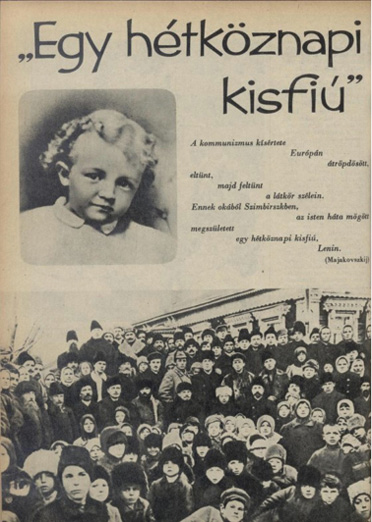
Picture 2. A Boy Like Any Other.
In Gyermekünk (“Our Child”), 1970, Vol. 2. No. 4. page 18.
The Real Photograph about the Boy
The third picture is the original; with the cut-out, it became a widespread portrait and contained only Lenin’s face on the first picture, which warns us of the importance of techniques, the “visual regimes” that may modify our perception (Dussel 2013). From this photograph, the unknown pictorial editors made a type of image closer to a painting, with the playful transitions of light and shadow (see the background in Picture 1 – the child came from brightness!); the resulting image is more suitable to the heroic-mythical times described below than this particular bourgeois genre of a family portrait. It was originated in painting too – members of the middle-class would order such pictures be made in the 19th century to record their families’ images, which rendered the painters’ and photographers’ profession profitable (Szilágyi 1982, pp. 73–74). Images made of the families were idealistic, because these portraits could be designated as representation forms in front of the public. A portrait remains from 1879, with eight members of Lenin’s family (e. g., Zevin & Golikov 1977, p. 158), and there is only one picture showing the children (Olga and Vladimir Uljanov) separately.
The Marxist theory of photography interpreted the portrait as a dialectic connection between typical and unique elements (Fischer 1980, p. 15): the bourgeois context is typical on the second photo, meanwhile the given family and child were unique, especially in the aspect of the later revolutionary movement. The picture was likely taken in a studio; the composition contains characteristics that refer to the family’s prosperity, like the cushioned chair and the fashionable clothes. The third picture had not spread widely in the Eastern Bloc, because the smaller face-portrait (Picture 1) was more appropriate to the idea of a conventional tribune rather than the image of bourgeois well-being suggested here. Vladimir became, some years later (in 1886), a member of the nobility because of his father’s position at the Assembly of Deputies of Simbirsk (Pipes 1996, p. 19) – this heritage and everything connected with or reminding of it associated him to this upper-class situation of Picture 3, and this could have been embarrassing for him in the Soviet times; not surprisingly, the child Lenin was represented only by his face in 1970.
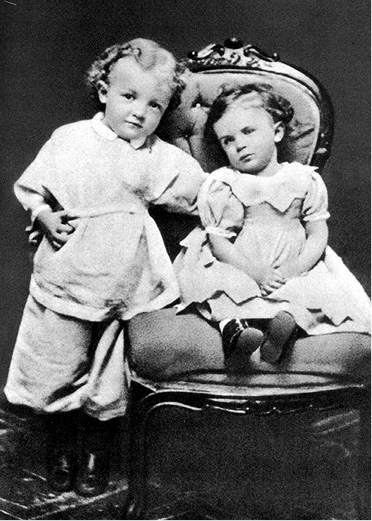
Picture 3. Vladimir Uljanov at the age of 4, with his younger sister, Olga. Simbirsk, 1874.
(Photographed by E. L. Zhakrzhevskaya). Retrieved on July 15, 2016, from https://www.marxists.org/archive/lenin/photo/family/012.htm
The clothes of the boy, a favorite style of those times by the representatives of the Russian farmers’ circle (little boots, white trousers), was typical of a high-middle class family with a progressive attitude. The Narodnik movement (with the slogan of “going to the people”) culminated in these decades; the clothes might reflect to their ideas, although Lenin struggled against them in his adulthood. We can analyze every personal photograph as part of the collective past with its cultural-historical background (Sturken 1999): the meanings are determined by family-memory and the retro perspective-view. After Lenin’s death, these pictures became the visual elements of his hagiography. The first item of his life’s chronology was the image of the four-year-old Vladimir Ilyich Uljanov – without the signs of any privileged class origins.
Transition from Photography into Painting
The next version of the same picture (a painting) appeared too in a Hungarian pedagogical journal, designed for the Pioneer-leaders (Úttörővezető). Picture 4 raises many questions about the paradigmatic shift and/or transitions between the photographic and the pictorial language, the problems of the observer (Crary 1990), and the changing forms of representational and color composition (Moholy-Nagy 1969), which were intentionally poor and pure here. The backdrop is dark, and the figure is white: as simple as the dualistic view of the communism.
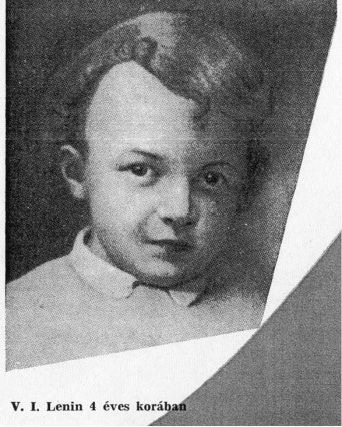
Picture 4. V. I. Lenin at the age of 4.
Úttörővezető (“Pioneer-Leader”), 1963, Vol. 17. No. 4., inside cover.
The relationship and interactions between photography and painting was an important topic to pictorialism, a decisive trend in visual representation during the late 19th and early 20th centuries. Representatives of this direction interpreted photographs as paintings, or similar artworks, and created scenic photos with a lack of sharp focus (Tóth 2010); like the fourth picture (a painting), which was probably grounded on the previous photographs. Ivan Parkhomenko was the artist (1870–1940) who made this oil on canvas in 1920 (Lenin/Ivan Parkhomenko). The painter combined realism with transcendence to suggest the unique character of a real individual. We can observe the original features of the photograph (the child’s face, hair, and shirt), but the backstage completely disappeared on the artwork – an opposition of the white figure and black foreground reflects pictorialism and a super-reality. Conversions between the two modalities, a translation from the painting to photography meant an important problem in the age of mechanical reproduction (Benjamin 2008), while the inverse direction (from photography to painting) implies the sublimation of the real figure and historical context into art and the sacral world. Lenin had existed at different levels; reality and myth interfere into each other in these representation spaces. The last (fifth) picture shows the original painting.
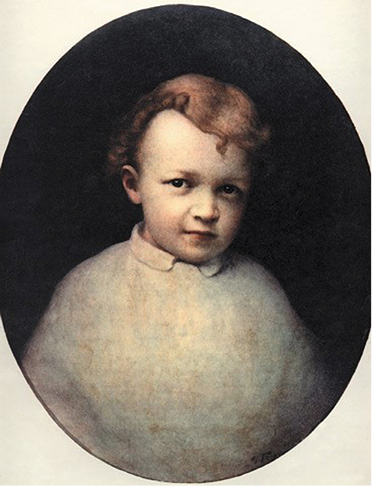
Picture 5. Parkhomenko, Ivan: V. I. Lenin at the age of 4 (1924).
Retrieved on July 15, 2016, from https://commons.wikimedia.org/wiki/File:Lenin_V_I_at_age_of_4.jpg
The enlightened figure appears from the dark past, with a more conscious and adult-like look (than before) to the better future – as small adults in Ariès famous work on the history of childhood (1962). In this aspect, the fifth picture expresses a pictorial (and cultural) convention; on the other hand, the early version of the future leader’s face is manifested as well. The oval-shaped portrait is a traditional one in this period, the same version being published in a popular book about Lenin’s life in 1950s Hungary (Lenin élete képekben 1950, p. 12). The painter changed the mimicry, position of the lips and face, so the previous angel-like child became an assertive, ready-to-fight person.
The Lenin myth started with constructing his life, selecting, forming, and decontextualizing its different elements, as we can see on these pictures. This meant a shortened and manipulated image, focusing and emphasizing some components while hiding others; the becoming portrait was separated from its original sociocultural background, transforming the individual into a timeless hero. The child as a symbol of the new world has been well-known in our culture, disposing the identification power, which was needed to the political regime.
Conclusions
As Catriona Kelly stated in a conference volume, “a major innovation of the twentieth century […] was the emergence of genres of political propaganda aimed explicitly at children” (Kelly 2004, p. 102). In the communist systems, “sovietized rituals” were used by the propaganda, which showed both continuity and innovation at the same time (Apor, Apor & Rees 2008, pp. 135–198). The politicized image of the innocent child of Lenin is a good example to this. The most interesting part of my analysis is the confrontation of realities and images and the existence of their entanglement. Bourdieu pointed out that the eye and perception is a historical-sociological construction (1996, pp. 313–322): it is very interesting how we see these conventional pictures then and now, with very different knowledge.
I review different versions of the same picture in this paper: an “ID-picture,” its layout in a journal, a family portrait, and a painting. Changes, transitions, continuities, and discontinuities can be observed through one figure, the role model of the “new man,” the final goal of communist propaganda (Cioflâncă 2010). It would be necessary to make a transnational perspective to future research, related to the connections between visual indoctrination in the Eastern Bloc and further (for example, for how the Soviet Union “used” Lenin for different purposes, see Fedosov & Konev 2015; Fedosov 2018). An impressive and broad field to study is the concept of indoctrination, with its philosophical and educational consequences (Snook 2010; Momanu 2012), because the key factor of every education is authority and belief – the question always rests on how to treat these aspects.
Several aspects of the Lenin Cult were useful in the analysis: the discourses about Lenin were influenced originally by the sacral sphere, even the scientific ones; the publication of the pictures in pedagogical journals ensured educational goals to make the next generations ideologically more conscious. Great historical figures have been models for a long time, introduced by editorial boards, teachers, politicians; the idea of political socialization describes the complex interrelation between pedagogy and politics (Szabó 2000). The political power uses values and norms in every decade, with images, celebrations, and symbols to unify the society and different communities and legitimize the control over them. The picture of “a boy like any other” might help this process, which draws historical trends closer to the ordinary people and makes heroes like Lenin more human.
Acknowledgements
The author would like to thank Iveta Ķestere (University of Latvia, Riga) for her helpful comments, which improved the paper in many ways.
Primary Sources
Feljegyzés a pedagógiai folyóiratok szerkesztőivel tartott megbeszélésről [Record of the meeting with the editors of the pedagogical journals]. 19 October 1959. MSZMP KB TKO [Hungarian Socialist Workers’ Party Central Committee Science and Cultural Department], 288. f. 33/1959/1. ő. e. MNL OL [Hungarian National Archive].
Határozati javaslat V. I. Lenin születése 100. évfordulójának megünneplésére [Proposal to the celebration of the 100th anniversary of Lenin’s birth]. 22 December 1969. MSZMP Pest Megyei Bizottsága Propaganda és Művelődési Osztály [Hungarian Socialist Workers’ Party Council of Pest County Department of Propaganda and Education]. 3/376. ő. e. PML (Archive of Pest County].
Iskolai ünnepélyek, megemlékezések márc. 15., márc. 21., április 4. és április 21. évfordulókról [Celebrations in the schools, relating to the anniversaries of March 15, March 21, April 4 and April 21]. Somogy Megyei Tanács Művelődésügyi Osztály [Council of Somogy County, Education Department], 27547-4/1958. Kaposvár, 7 March 1958. Tabi Állami Gimnázium Irattára [Archive of the State High School of Tab].
Vass. H. & Ságvári, Á. (1973, eds.). A Magyar Szocialista Munkáspárt határozatai és dokumentumai, 1956–1962 [Decrees and Documents of the Hungarian Socialist Workers’ Party, 1956–1962]. Budapest: Kossuth.
References
Apor, B., Apor, P. & Rees, E. A. (2008), eds. The Sovietization of Eastern Europe: New Perspectives on the Postwar Period. Washington: New Academia Publishing. https://doi.org/10.1162/jcws.2010.12.2.126
Ariès, P. (1962). Centuries of Childhood: A Social History of Family Life. New York: Vintage.
Assmann, J. (2011). Cultural Memory and Early Civilization: Writing, Remembrance, and Political Imagination. New York: Cambridge University Press. https://doi.org/10.1017/cbo9780511996306
Barthes, R. (1977). Image, Music, Text. London: Fontana Press.
Benjamin, W. (2008). The Work of Art in the Age of Mechanical Reproduction. London: Penguin Books.
Bonnell, Victoria E. (1998). Iconography of Power. Soviet Political Posters under Lenin and Stalin. Berkeley–Los Angeles–London: University of California Press. https://doi.org/10.1086/ahr/103.5.1656
Bourdieu, P. (1996): The Rules of Art: Genesis and Structure of the Literary Field. Stanford: Stanford University Press.
Burke, P. (2001). Eyewitnessing. The Use of Images as Historical Evidence. Ithaca: Cornell University Press.
Cioflâncă, A. (2010). The Communist Propagandistic Model. Towards A Cultural Genealogy. Studia Politica. Romanian Political Science Review, 3, 447–482.
Connerton, P. (1989). How societies remember. Cambridge: Cambridge University Press.
Coquin, F.-X. (1990). Lenin-ikonográfia [Lenin Iconography]. Világosság, 7, 531–541.
Crary, J. (1990). Techniques of the Observer: On Vision and Modernity in the Nineteenth Century. Cambridge–London: MIT Press.
Dekker, J. H. J. (2015). Image as representations: visual sources on education and childhood in the past. Paedagogica Historica: International Journal of the History of Education, 6, 702–715. https://doi.org/10.1080/00309230.2015.1061565
Depaepe, M., & Henkens, B. (2000). The History of Education and the Challenge of the Visual. Paedagogica Historica: International Journal of the History of Education, 1, 10–17. https://doi.org/10.1080/0030923000360101
Dussel, I. (2013). The Visual Turn in the History of Education: Four Comments for a Historiographical Discussion. In T. S. Popkewitz (ed.) Rethinking the History of Education: Transnational Perspectives on Its Questions, Methods, and Knowledge. (pp. 29–49). New York: Palgrave Macmillan. https://doi.org/10.1057/9781137000705_2
Dussel, I. (2018). Truth in Propagandistic Images. Reflections of an Enigmatic Corpus (Westerbork, 1944). Historia y Memoria de la Educación, 8, 59–95.
Dussel, I. & Priem K. (2017). The visual in histories of education: a reappraisal. Paedagogica Historica: International Journal of the History of Education, 6, 641–649. https://doi.org/10.1080/00309230.2017.1392582
Enker, B. (1987). Die Anfänge des Leninkultes. Jahrbücher für Geschichte Osteuropas, 35(4), 534–555.
Enker, B. (1996). Leninkult und mythisches Denken in der sowjetischen Öffentlichkeit 1924. Jahrbücher für Geschichte Osteuropas, 3, 431–455.
Fedosov, E. A. & Konev, K. A. (2015). Советский плакат времен Великой Отечественной войны: общенациональный и региональный аспекты. Русин, 2, 189–209. https://doi.org/10.17223/18572685/40/12
Fedosov, E. A. (2018). “Po puti Lenina k schastju i slave”: vizualnaja propaganda 1940–1960-ch gg. i politicheskii ideal sovetskogo cheloveka. [«By Lenin’s way to happiness and glory»: visual propaganda of the 1940s-1960s and the political ideal of the Soviet person]. Vestnik Tomskogo gos. un-ta, 431, 132–140. https://doi.org/10.17223/15617793/431/18
Fendler, L. (2017). Apertures of documentation: reading images in educational history. Paedagogica Historica: International Journal of the History of Education, 6, 751–762. https://doi.org/10.1080/00309230.2017.1380052
Fischer, K. (1980). Porträtfotografie. Leipzig: VEB Fotokinoverlag.
Grosvenor, I. & Lawn, M. (2001). Ways of seeing in education and schooling: emerging historiographies. History of Education, 2, 105–108. https://doi.org/10.1080/00467600010012382
Higonnet, A. (1998). Pictures of Innocence: The History and Crisis of Ideal Childhood. London: Thames and Hudson.
Horváth, S. (2017). Stalinism Reloaded: Everyday Life in Stalin-City, Hungary. Bloomington–Indianapolis: Indiana University Press. https://doi.org/10.2307/j.ctt2005sp9
Jangfeldt, B. (2014). Mayakovsky: A Biography. Chicago – London: The University of Chicago Press.
Keller, R. (2013). Doing Discourse Research: An Introduction for Social Scientists. Los Angeles – London – New Delhi – Singapore – Washington: SAGE.
Kelly, C. (2004). Grandpa Lenin and Uncle Stalin: Soviet Leader Cults for Little Children. In B. Apor, J. C. Behrends, P. Jones & E. A. Rees (eds.) The Leader Cult in Communist Dictatorships: Stalin and the Eastern Bloc. Basingstoke-New York: Palgrave Macmillan. 102–122. https://doi.org/10.1057/9780230518216_6
Kenez, P. (1985). The Birth of the Propaganda State: Soviet Methods of Mass Mobilization, 1917–1929. Cambridge: Cambridge University Press. https://doi.org/10.3138/cjh.21.3.464
Krausz, T. (2008). Lenin. Társadalomelméleti konstrukció [Lenin: Sociological Reconstruction]. Budapest: Napvilág Kiadó.
Lenin/Ivan Parkhomenko. Retrieved June 1 2019, from: https://www.akg-images.com/CS.aspx?VP3=SearchResult&ITEMID=2UMDHU9FZ5X6&LANGSWI=1&LANG=German
Lenin élete képekben [The Life of Lenin in Pictures] (1950). Budapest: Szikra.
Mayakovsky, V. (1965). Poems. Moscow: Progress.
Mayakovsky, V. (1985). Selected Verse (Volume I.). Raduga Publishers.
Moholy-Nagy, L. (1967). Painting, Photography, Film. London: Lund Humphries.
Momanu, M. (2012). The Pedagogical Dimension of Indoctrination: Criticism of Indoctrination and the Constructivism in Education. Meta: Research in Hermeneutics, Phenomenologym and Practical Philosophy, 1, 88–105.
Ormos, M. (1994). Boldogság-ideológiák a XX. században [Ideologies of Happiness in the 20th Century]. Magyar Tudomány, 10, 1189–1201.
Pinfold, D. (2011). ’Das Mündel will Vormund sein’: The GDR State as Child. German Life and Letters, 2, 283–304. https://doi.org/10.1111/j.1468-0483.2010.01534.x
Pipes, R. (1996). The Unknown Lenin: From the Secret Archives. New Haven – London: Yale University Press.
Riegel, K. G. (2005). Marxism-Leninism as a Political Religion. Totalitarian Movements and Political Religion, 1, 97–126. https://doi.org/10.1080/14690760500099788
Rousmaniere, K. (2001). Questioning the visual in the history of education. History of Education, 2, 109–116. https://doi.org/10.1080/00467600010012391
Snook, I. A. (2010), ed. Concepts of indoctrination: Philosophical essays. London–Boston: Routledge & Kegan Paul.
Sobe, N. (2012). Researching emotion and affect in the history of education. History of Education, 5, 689–695. https://doi.org/10.1080/0046760x.2012.696150
Somogyvári, L. (2014). A tudásátadás, nevelés intézményi és intézményen kívüli terei: Képelemzések a magyar pedagógiai szaksajtóban, 1960–1970 [The Knowledge Transfer and Spaces of Education inside and outside the Institution: Visual Interpretations in the Hungarian Educational Periodicals, 1960–1970]. Disszertáció [PhD dissertation], Pécs: PTE.
Sturken, M. (1999). The Image as Memorial: Personal Photographs in Cultural Memory. In Hirsch, M. (ed.): The Familial Gaze. Hanover: Dartmouth College Press University Press of New England. 178–196.
Swain, G. & Swain, N. (1993). Eastern Europe since 1945. London: Macmillan.
Szabó, I. (2000). A pártállam gyermekei. Tanulmányok a magyar politikai szocializációról [Children of the Party-State. Studies about the Hungarian Political Socialization]. Budapest: Hatodik Síp Alapítvány – Új Mandátum Könyvkiadó.
Szilágyi, G. (1982). A fotóművészet története a fényrajztól a holográfiáig [The Art of Photography from the Photogram to Holography]. Budapest: Képzőművészeti Alap Kiadóvállalata.
Tóth, B. Z. (2010). Modernista törekvések a magyar fotográfiában [Modernist Trends in the Hungarian Photography]. Forrás, 7-8, 101–126.
Tumarkin, N. (1981). Religion, Bolshevism and the Origins of the Lenin Cult. Russian Review, 1, 35–46. https://doi.org/10.2307/128733
Tumarkin, N. (1983). Political Ritual and the Cult of Lenin. Human Rights Quarterly, 2, 203–206. https://doi.org/10.2307/762257
Zakharova, L. (2013). Everyday Life Under Communism: Practices and Objects. Special Issue of Annales, 2, 209–217.
Zevin, V. & Golikov, G. (1977). Vladimir Ilyich Lenin. Life and Work. Moscow: Novosti Press Agency Publishing House.
Zviagintseva, A. P. (1970). The Lenin Corner in the School. Soviet Education, 3–5, 29–35. https://doi.org/10.2753/res1060-93931203040529